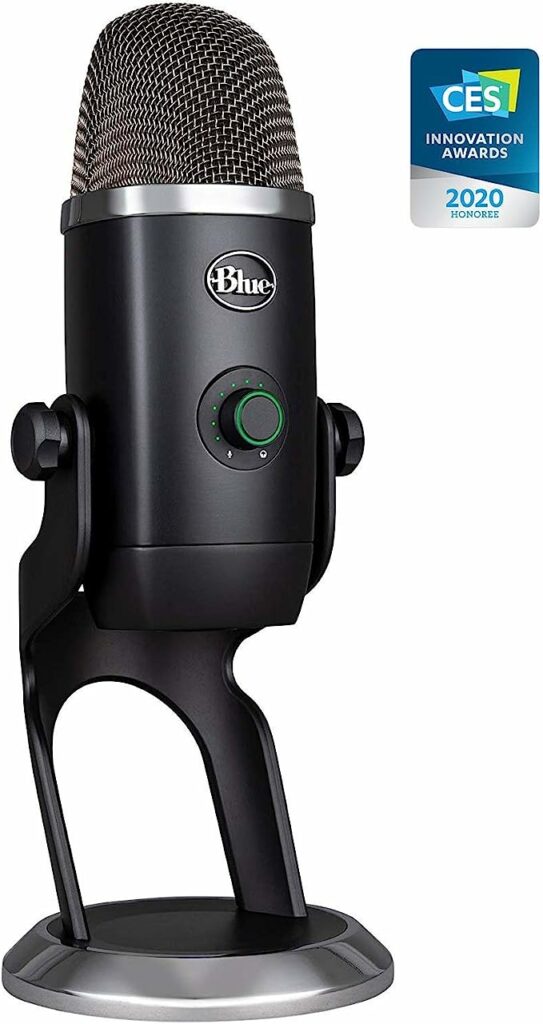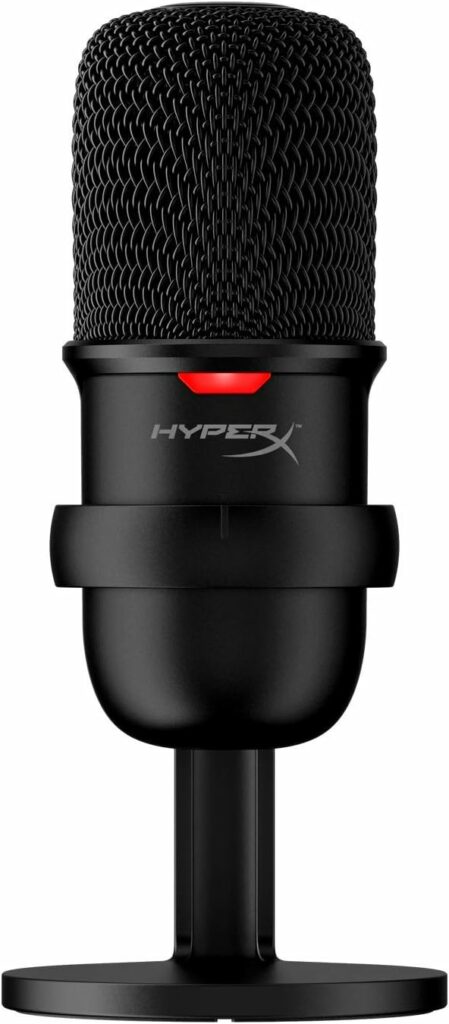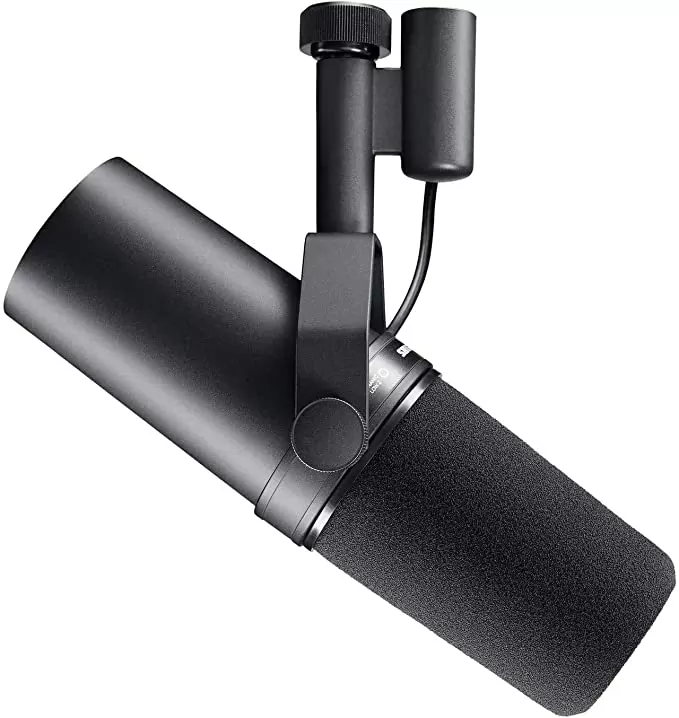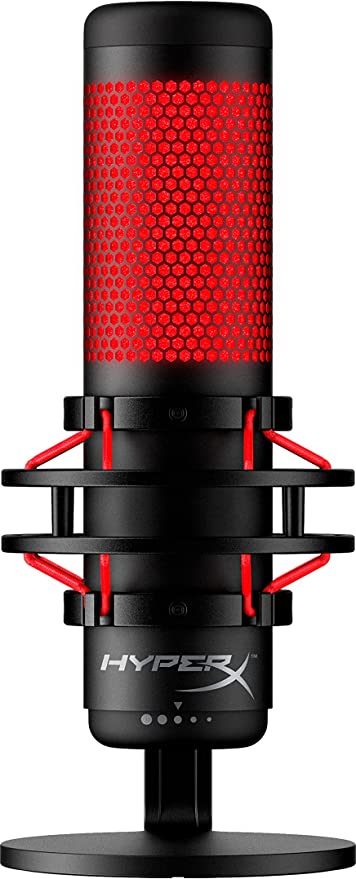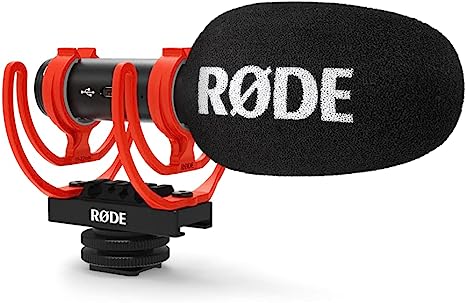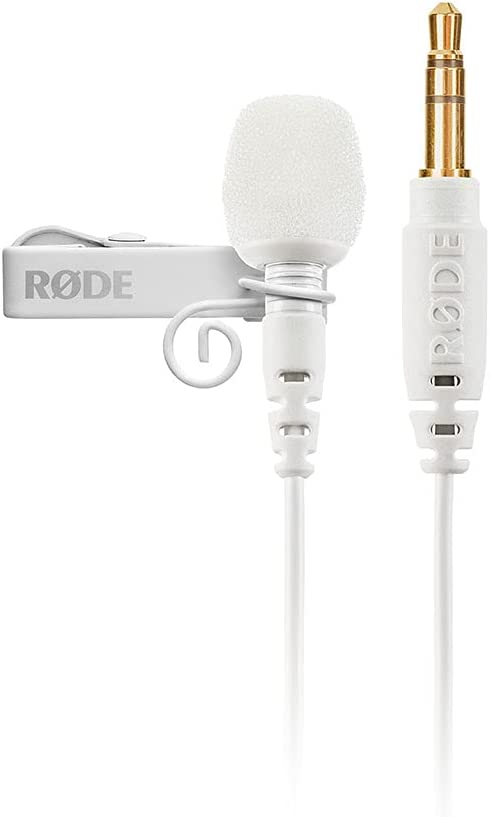Whether you’re starting a new podcast or making gaming videos, audio quality is an integral part of your production value. Yes, you can create amazing videos for YouTube with nothing more than your smartphone, a tripod stand, and a backdrop, but as you scale your channel, your video quality needs to scale alongside it. Also, audiences generally appreciate stellar audio quality, so your videos will get better engagement when your audio is clear.
A great place to start to improve your audio quality is choosing the right microphones for the content you make. The problem is, there are, quite literally, millions of microphone options you can choose from — which is a daunting process that carries huge risks of you choosing the wrong one(s).
The good news, however, is that we’ve done the groundwork and come up with the best choices for you based on the kind of content you create.
Skip ahead:
- Microphone polar patterns
- Types of Microphones for YouTube
- Other types of microphones
- Factors to Consider When Choosing a YouTube Microphone
- Best Microphones for YouTube
- Comparison Table of Recommended YouTube Microphones
- Additional Tips for Recording YouTube Audio
- Invest in a high-quality microphone for your YouTube videos
- FAQ
Microphone polar patterns
A polar pattern tells you how a microphone picks up sound and where it picks it up from. Microphone polar patterns can help you answer questions like:
- Do I need to stay directly in front of the mic to get the best sound quality?
- Can I stay away from the mic a bit and still get great audio quality?
- Is it possible to keep the mic out of the shot and move around, but still get great sound?
When you know polar patterns, you’ll be able to pit the setup of your YouTube videos against the microphone options you have, so you’ll know which one is best for you.
Here are the main microphone polar patterns:
Cardioid pattern
As you might’ve guessed, the term “cardioid” is derived from a Latin word that means “heart-shaped”. A cardioid microphone picks up sound in a heart shape. It predominantly records what’s in front of the microphone and rejects sounds coming from the back of the mic.
Microphones with cardioid polar patterns make good YouTube microphones because they don’t pick up background noise easily.
Bidirectional pattern
Microphones with a bidirectional polar pattern pick up sounds from two directions: the front and the back of the microphones. They reject any sounds from the sides, above, and below the mic.
Omnidirectional pattern
Microphones with omnidirectional polar patterns pick up sound equally from all directions, including the background. So if you’re recording in public or in a big group setting, mics with omnidirectional patterns are the best for you.
Types of Microphones for YouTube
Before getting into the actual microphones we think are best for YouTube content creation, let’s discuss the types of microphones that exist. There are three main classes of microphones: dynamic, condenser, and ribbon microphones.
Dynamic microphones
Think back to the last concert or live performance you attended. Chances are, the microphone the singer(s) used is a dynamic mic. Dynamic microphones are great for capturing louder sounds and cutting out background noise because the coil and magnets inside are sturdy and don’t wear out easily.
So if you’re singing/playing music in public, doing street interviews, or recording videos in an otherwise noisy area, dynamic microphones are your best bet for getting rid of background distractions.
Condenser microphones
Instead of a coil and magnets, condenser microphones use capacitor plates, which enable them to be much more sensitive to smaller vibrations than dynamic microphones. Condenser microphones can pick up sound very clearly, so they capture a lot of the subtleties and nuances in a person’s voice. This is especially important when you’re recording a podcast, a voiceover, a vlog, or a singer in a booth.
Ribbon microphones
Ribbon microphones are the VIP of mics. They are much less common than dynamic and condenser mics, but they have better quality and can be used to record almost anything, including drums, brass, guitars, and even room ambiance. That’s why many artists or creators who record in live-in or home studios use them.
Ribbon mics are also bidirectional (more on that below), which means they capture sound from the front and back of the mic, while rejecting sounds from above and below, and the sides. So while ribbon mics pick up smaller sounds like a condenser mic, they add more warmth to the recording to give it a more “natural” sound.
Other types of microphones
Dynamic and condenser microphones are further broken down into other mic types, including USB microphones, shotgun microphones, lavalier microphones, and XLR microphones.
USB microphones
Many YouTubers, especially those who are just starting their YouTube journey, choose USB microphones because they are affordable, convenient, and easy to use. Since USB ports are universal, you can connect a USB mic to many different devices. USB mics are also plug-and-play; they require no setup or additional recording equipment for them to work well.
XLR microphones
XLR microphones are analog mics that are usually connected to a recording device via an XLR cable. Not only are XLR mics the most common microphone type available, but they have lower noise and better sound quality than their USB counterparts. That’s why they’re the go-to microphone type for podcasters, interviewers, singers, and radio stations.
However, unlike USB microphones, you cannot connect XLR mics directly to your computer. To use an XLR microphone, you’ll need an additional audio interface that’ll enable your computer to see the mic.
Shotgun microphones
Shotgun mics are a type of condenser microphone that works well if you plan to record people on camera or make vlogs when attached to a DSLR camera. These mics are versatile, come in a variety of polar patterns, and can work in different situations, but you’ll need to know how to position them if you’re going to get the best sound.
For example, shotgun mics are often used in film and TV recording; the operator holds the shotgun mic over the actors pointing down towards their chests during the video shoot. If the operator points the microphone upwards into the actor’s mouth, it’ll pick up sounds behind the person too — which can impede recording quality.
Lavalier microphones
A Lavalier microphone is a small, discreet microphone that allows you to make recordings with high-quality audio without worrying about positioning. Lavalier mics have an omnidirectional polar pattern, so they can pick up sounds from any direction. This enables you to conceal the microphone on your subject or hide it in a nearby place without risking audio quality.
Lavalier mics are great for interviews, documentaries, and live broadcasts, as they don’t have to be visible in the shot.
Pro tip: Your Lavalier microphone has to be close to your subject to pick up the sound of their voice, and should be concealed to prevent abrasions and/or bumps that can destroy the mic.
Factors to Consider When Choosing a YouTube Microphone
Before you go shopping for a microphone for recording YouTube videos, here are a few things you should consider:
Budget
“How much money are you willing to spend on a new microphone?”
That should be the first question you ask yourself before purchasing a YouTube mic. There are microphones at every price point that can deliver decent-to-great audio quality. But as a rule of thumb: the more you invest, the better audio quality you get.
That said, if you’re a beginner, you shouldn’t be shelling out $1,000 for a new microphone. There’s nothing inherently wrong with doing that, but starting at a lower or mid-range price point will allow you to save money and test the waters to find what really works for you. As your channel develops, you can always upgrade to a better (and more expensive) microphone.
But if you’re an experienced YouTuber, then you already have an audience that expects a certain video quality from you, so it makes sense to spend a little more on a microphone. And you’ll be able to make a better choice too, because by then, you already know how specific mic features work and which ones are necessary for the type of content you create.
Content
Speaking of content, the microphone you choose depends largely on what you plan to record. For example, the microphone you’ll need to record yourself singing in a booth is different from the one you need to record a vlog of your cross-country drive. The same goes for the mic you need to record a 1-on-1 podcast and for the mic you need to record public interviews.
Where you record
The place you record your YouTube videos matters when purchasing a microphone because different mics are designed for different environments. Some microphones work great for recording in enclosed spaces while others are better suited for recording on the go.
For example, shotgun mics are great for studio recordings, but they’re not as good for recording vlogs. And Lavalier mics are best suited for on-the-go recordings because they’re portable. But unlike shotgun mics, they won’t produce great audio quality in a controlled studio environment.
Features
Before ordering a microphone online or visiting a music shop, learn about the different microphone features so you know which one you should look for as you browse through the options you have.
For example, if you plan to record videos out in the open, look for microphones that have built-in pop filters and automatic noise reductions, as those will minimize background noise in your final video. If you’ll be recording in a studio, then built-in mic features may not be your priority because you can control background noise with shock mounts, and external pop filters.
If you’ll be monitoring audio quality during post-production, the microphone you choose needs to have a headphone jack. You also need to know how you’ll connect your microphone to other equipment, like an audio interface, for instance. So clarify whether you want a USB or XLR microphone.
Best Microphones for YouTube
And here’s the part you’ve been waiting for. Below are five of the best microphones for YouTube, based on the kind of content you create.
Best all-around microphone – Blue Yeti X
Price: $91
When game streaming and podcasting became mainstream, the Blue Yeti mics were some of the most used mics because of how affordable, flexible, and high-quality they were. That hasn’t changed a bit.
The Blue Yeti X condenser microphone offers four recording patterns — cardioid, bi-directional, omnidirectional, and stereo. So whether you’re recording in an enclosed space, in public, or behind the scenes, the Blue Yeti X will serve you well.
While the exterior of the Blue Yeti X is similar to the famed original Blue Yeti, there are some differences. First, the Blue Yeti X records 24-bit/48kHz audio, which is considerably better than the original which records 16-bit/48kHz audio. This feature gives you more flexibility, especially if you do a lot of post-production work.
What’s more, the Blue Yeti X is a USB microphone, so you can easily connect it to different devices without having to use other complementary equipment, like an audio interface.
Best microphone for beginners – HyperX SoloCast
Price: $39.99
If you’re a beginner on YouTube, HyperX SoloCast is a great microphone to start with. This mic has a compact, lightweight, and uncomplicated design that’ll smoothly integrate with your existing setup, whatever it is.
The SoloCast is a condenser microphone with a cardioid polar pattern, so it’s very sensitive to sounds directly in front of it — which makes it ideal for gamers, podcasters, and voiceovers.
While this mic isn’t versatile in terms of polar patterns, it does offer an impressive and clear sound, while filtering out background noises. The mic connects with other devices using a USB input and is compatible with both Mac and Windows operating systems.
Best microphone for podcasters and singers – Shure SM7B
Price: $393.90
The Shure SM7 microphone was introduced in 1973 and was heavily used in Michael Jackson’s Thriller record. So it’s no surprise that the Shure SM7B mic is the go-to dynamic microphone for musicians, podcast producers, and other creators whose content revolves mainly around audio.
The $393.90 price tag is on the high side, but you’ll paying for two things: top-notch construction and professional performance. As a cardioid microphone with noise-diminishing technology, the SM7B picks up clear sounds in front of it, while ignoring background and off-axis noise. So if you’re recording in a controlled environment like a studio, this is the best mic for you.
This mic also has a pre-installed pop filter and an A7WS detachable windscreen that helps to reduce fricatives and plosives, so you can speak freely without being conscious of your proximity to the recording capsule. What’s more, the Shure SM7B can auto-correct itself to give you the best audio quality. So you can move around in the room, and the mic will make small adjustments to regulate the sound.
Note: This mic isn’t for beginners. It’s for professionals and industry veterans who have ample experience using mics and know the features they need to create the best content.
Best microphone for gaming streamers – HyperX QuadCast
Price: $124.31
The HyperX QuadCast is a USB condenser microphone that offers three pickup patterns — cardioid, hyper-cardioid, and bidirectional. It is designed to help gamers, streamers, and podcasters get clear and rich audio quality on their Twitch and YouTube videos.
In true condenser mic faction, the QuadCast is very sensitive to sounds, especially from the back and front of the mic. However, this mic has a pop filter that breaks up the pressure spikes that accompany plosive sounds. There’s also a built-in anti-vibration shock mount that protects your audio from banging, rattling, and shifting noises, which you might make as you play your game or stream your video.
This microphone is compatible with PlayStation, PC, and MacOS, and is as easy to use as any other USB microphone out there.
Best microphone for vlogging – Rode VideoMic GO II
Price: $99
The Rode VideoMic GO II is a portable shotgun microphone that is designed to help you record high-quality audio on the go. So if you’re a vlogger who documents your everyday life, this mic can be a valuable asset.
This mic has a super-cardioid polar pattern, which means it is very sensitive to on-axis sounds (where the mic points), and reduces sounds from the sides. However, it also has an integrated shock mount that absorbs vibrations and provides you with better control over your recording.
Finally, the Rode VideoMic GO II easily mouths onto a boom pole or DSLR for instant recording, and has a 3.5mm input that makes it easy for you to connect it to other cameras and mobile devices.
Note: A super-cardioid mic is even more focused on sounds in front of a mic than a typical cardioid mic, so you need to be conscious of where the mic is pointing as you record.
Best Lavalier microphone – Rode SmartLav+
Price: $76.99
The Rode SmartLav+ is a portable Lavalier microphone that has a wide-range frequency response of 20Hz to 20kHz, which covers the entire spectrum of the human ear, giving your audio a deep, rich sound.
This mic has an omnidirectional condenser capsule, so it picks up sound from all directions — which makes it suitable for recording outdoors. It also has a Kevlar-reinforced cable, and there’s a pop filter that absorbs vibrations and ensures clear speech. The cable, however, is just 1.2m long, so you’ll need to be close to the device you’re recording to when using the microphone.
The Rode SmartLav+ has a 3.5mm jack and is compatible with both Android and iOS devices, so you won’t have any problems setting it up. It’s also compatible with any audio recording app that uses the headphone jack, including the Rode Reporter app.
Overall, this microphone is a great choice, whether you’re just starting out on YouTube or you’re an experienced YouTuber.
Comparison Table of Recommended YouTube Microphones
Below’s a comparison table that breaks down the key features and specifications of all the recommended microphones:
| Blue Yeti X | HyperX SoloCast | Shure SM7B | HyperX QuadCast | Rode VideoMic GO II | Rode SmartLav+ | |
| Price | $91 | $39.99 | $393.90 | $124.31 | $99 | $76.99 |
| Polar patterns | Cardioid, stereo, bidirectional, and omnidirectional | Cardioid | Cardioid | Cardioid, stereo, bidirectional, and omnidirectional | Super-cardioid | Omnidirectional |
| Key features | High-resolution 24-bit/48kHz audio recording Four condenser microphone capsules Adjustable gain control LED metering for easy monitoring | Compact and portable design Plug-and-play setup Tap-to-mute sensor Compatible with PS4, PC, and Mac | Dynamic microphone Flat, wide-range frequency response Internal “air suspension” shock isolation Bass roll-off and mid-range emphasis control | Built-in anti-vibration shock mount Tap-to-mute sensor Gain control and headphone output | Shotgun microphone High-pass pop filter to reduce low-frequency noise Adjustable gain control Rycote Lyre shock mounting system | Lapel microphone for mobile devices Kevlar-reinforced cable for durability Foam pop shield |
| Audio quality | High-quality audio reproduction Digital signal processing (DSP) | Clear and balanced sound Good sensitivity | Warm, rich sound Excellent background noise rejection | Clear and detailed sound 24-bit/48kHz sampling rate | High-quality audio reproduction Excellent off-axis rejection | Crisp and natural sound reproduction Good sensitivity |
| Connectivity | USB connection Headphone output | USB connection Headphone output | XLR connection Requires an audio interface or mixer | USB connection Headphone output | 3.5mm TRS output (requires camera with TRS input) Battery-powered (9V battery) | 3.5mm TRRS connection Compatible with smartphones and tablets |
Additional Tips for Recording YouTube Audio
As you set up your microphone for use, here are some additional tips to keep in mind as you record your audio for YouTube:
- Pay attention to your microphone placement. Ideally, you should be around 3-5 inches away from the microphone to get great audio quality. The further you are from the mic, the harder it’ll be to capture clear sound.
Your microphone should be in line with or close to your (or the speaker’s) mouth. Placing a mic too far above or below can cause it to pick up background noise.
- Keep your microphone in one place throughout the recording. Unless you’re using a Lavalier mic or one that’s specifically designed for on-the-go recordings, you should keep your microphone at the distance and height you started recording with for the entirety of the video. Moving the microphone as you record will mess up the clarity and volume of the audio.
Pro tip: You can use a microphone stand — tripod, round base, desktop, and overhead stands — to help keep the microphone in place. This is especially helpful if you move your hands around while talking.
- Speak slowly and clearly. Speaking too fast in your YouTube videos not only makes you sound nervous, but also messes up the audio quality and makes editing the audio difficult. To make your videos sound better, speak slowly and clearly; you can get rid of long pauses and filler words in the post-production process.
Pro tip: You can keep some notes to guide you on the points to cover as you record your video. Don’t write a full script, though, so you don’t sound unnatural.
- Don’t tap surfaces when talking. As you record your YouTube video, keep in mind that the microphone you’re using is sensitive to noise. If you keep tapping on surfaces as you speak, your mic will pick it up and it may annoy your viewers.
- Remove background sounds in post-production. No matter how hard you try, there’ll be times when you can’t completely avoid background noises — especially if you’re recording outdoors. So after recording your video, use software like Final Cut Pro and Premiere Pro to get rid of any background noise your mic might’ve picked up.
Pro tip: As you edit out background noise, also remove extended pauses or unnecessary parts from your video.
Invest in a high-quality microphone for your YouTube videos
The audio is just as important as the visuals in your YouTube videos. It doesn’t have to be perfect, but you should try hard to ensure that your viewers find it easy to listen to. The best way to do that is to invest in a high-quality microphone.
Using the right microphone will ensure that the videos you create capture your (and other speakers’) voice(s) clearly, while reducing (or completely muting) unnecessary background noises. This will improve the overall quality of your videos, as well as boost audience engagement.
The microphones outlined above are some of the best mics you can find on the market. Explore them and choose the one that best suits your needs — and get to recording!
FAQ
Do I need an expensive microphone for YouTube videos?
No, you don’t need an expensive microphone to get great audio quality for your YouTube videos. While the more expensive mics generally offer better sound, you can find amazing mics under $150 that’ll serve you just as well — like the HyperX SoloCast and the Blue Yeti X.
What is the best microphone for vlogging on YouTube?
The best microphone for vlogging on YouTube is the Rode VideoMic, which has a small, compact design that makes it easy to carry around. This mic has a super-cardioid polar pattern that allows it to pick up clear sounds right in front of it and reject sounds from the sides, above and below. It also has an internal shock mount that reduces background noise.
Are wireless microphones a good option for YouTube content creators?
The upside of using wireless microphones as a YouTube content creator is that you have freedom of movement and there’s significantly less chance of you tripping over wires in your recording space. The downside, however, is that wireless microphones can have frequency issues and run on batteries that aren’t always reliable.
Can I use a USB microphone for YouTube videos?
Yes, you can. In fact, USB microphones are more convenient than XLR microphones because all you have to do is plug them in and start using them. You don’t need additional things like an audio interface to use USB microphones.
How can I improve the audio quality of my existing YouTube videos?
The best way to improve the audio quality of your existing YouTube videos is to use high-quality audio editing software like Adobe Audition and Audacity to edit them.

